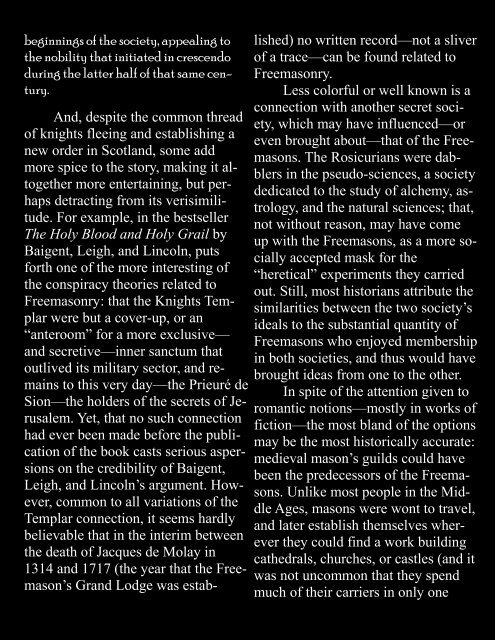The Tempest - Saint John's School
The Tempest - Saint John's School
The Tempest - Saint John's School
Create successful ePaper yourself
Turn your PDF publications into a flip-book with our unique Google optimized e-Paper software.
eginnings of the society, appealing to<br />
the nobility that initiated in crescendo<br />
during the latter half of that same century.<br />
And, despite the common thread<br />
of knights fleeing and establishing a<br />
new order in Scotland, some add<br />
more spice to the story, making it altogether<br />
more entertaining, but perhaps<br />
detracting from its verisimilitude.<br />
For example, in the bestseller<br />
<strong>The</strong> Holy Blood and Holy Grail by<br />
Baigent, Leigh, and Lincoln, puts<br />
forth one of the more interesting of<br />
the conspiracy theories related to<br />
Freemasonry: that the Knights Templar<br />
were but a cover-up, or an<br />
“anteroom” for a more exclusive—<br />
and secretive—inner sanctum that<br />
outlived its military sector, and remains<br />
to this very day—the Prieuré de<br />
Sion—the holders of the secrets of Jerusalem.<br />
Yet, that no such connection<br />
had ever been made before the publication<br />
of the book casts serious aspersions<br />
on the credibility of Baigent,<br />
Leigh, and Lincoln’s argument. However,<br />
common to all variations of the<br />
Templar connection, it seems hardly<br />
believable that in the interim between<br />
the death of Jacques de Molay in<br />
1314 and 1717 (the year that the Freemason’s<br />
Grand Lodge was estab-<br />
lished) no written record—not a sliver<br />
of a trace—can be found related to<br />
Freemasonry.<br />
Less colorful or well known is a<br />
connection with another secret society,<br />
which may have influenced—or<br />
even brought about—that of the Freemasons.<br />
<strong>The</strong> Rosicurians were dabblers<br />
in the pseudo-sciences, a society<br />
dedicated to the study of alchemy, astrology,<br />
and the natural sciences; that,<br />
not without reason, may have come<br />
up with the Freemasons, as a more socially<br />
accepted mask for the<br />
“heretical” experiments they carried<br />
out. Still, most historians attribute the<br />
similarities between the two society’s<br />
ideals to the substantial quantity of<br />
Freemasons who enjoyed membership<br />
in both societies, and thus would have<br />
brought ideas from one to the other.<br />
In spite of the attention given to<br />
romantic notions—mostly in works of<br />
fiction—the most bland of the options<br />
may be the most historically accurate:<br />
medieval mason’s guilds could have<br />
been the predecessors of the Freemasons.<br />
Unlike most people in the Middle<br />
Ages, masons were wont to travel,<br />
and later establish themselves wherever<br />
they could find a work building<br />
cathedrals, churches, or castles (and it<br />
was not uncommon that they spend<br />
much of their carriers in only one


